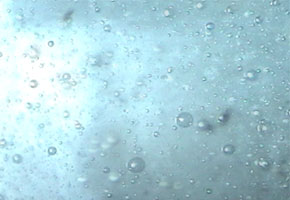

Equipment reduces disease-causing microorganisms in wastewater through physical phenomenon involving sudden drops in pressure.
Equipment reduces disease-causing microorganisms in wastewater through physical phenomenon involving sudden drops in pressure.
Equipment reduces disease-causing microorganisms in wastewater through physical phenomenon involving sudden drops in pressure.

Equipment reduces disease-causing microorganisms in wastewater through physical phenomenon involving sudden drops in pressure.
By Mônica Pileggi
Agência FAPESP – Cavitation, a physical phenomenon caused by a sudden fall in pressure that reaches vapor pressure in the water generally observed in hydraulic systems, is an alternative to chemical products in disinfecting wastewater.
The new ally to the environment is an apparatus developed by José Gilberto Dalfré Filho, professor in the Department of Hydric Resources at the Universidade Estadual de Campinas (Unicamp) School of Civil Engineering, Architecture and Urban Studies.
According to Dalfré, the idea for the study came up during his doctoral research, which he presented in 2005 at Unicamp with an analysis of the erosion caused by cavitation on solid surfaces, mainly in materials used in hydraulic structures such as spillways in dams.
“In the initial project, we simulated the erosion by cavitation in these structures using a cavitating jet. Afterward, aside from observing that the equipment could be improved to be more efficient, we also found other uses for cavitating jets, especially disinfecting and removal of persistent compounds,” he told Agência FAPESP.
The purpose of the equipment is to apply the same cavitation principle to eliminate organisms found in water that can cause health problems to humans, reducing the use of chemicals for wastewater clean-up.
Similar to what happens in cavitation, a high-pressure jet generates high levels of shear (or tangential) stress, forming vortices. These vortices produce bubbles that increase in size and stop the vortices themselves.
“In destroying them, the pressure around the bubbles becomes extremely high, causing them to implode,” explained Dalfré. When the implosion happens (at a speed that can be as much as 100 meters per second) a large pressure wave is released, affecting the microorganisms.
“If the liquid is contaminated with bacteria, the high tension from the implosion can destroy the cells of these organisms,” he explained.
The pressure achieved in the study was not sufficient to totally eliminate the number of organisms present in the water. “We achieved significant disinfection. Right now, we are redesigning the equipment to reach higher levels of disinfection, with the goal of cleaning the water enough that it is suitable for human consumption,” he said.
Dalfré also pointed out the equipment’s energy efficiency as compared to other alternative methods of wastewater clean-up. “It uses less energy than other cavitation processes like ultra-sonic, which needs high temperatures,” he said.
Republish
The Agency FAPESP licenses news via Creative Commons (CC-BY-NC-ND) so that they can be republished free of charge and in a simple way by other digital or printed vehicles. Agência FAPESP must be credited as the source of the content being republished and the name of the reporter (if any) must be attributed. Using the HMTL button below allows compliance with these rules, detailed in Digital Republishing Policy FAPESP.





